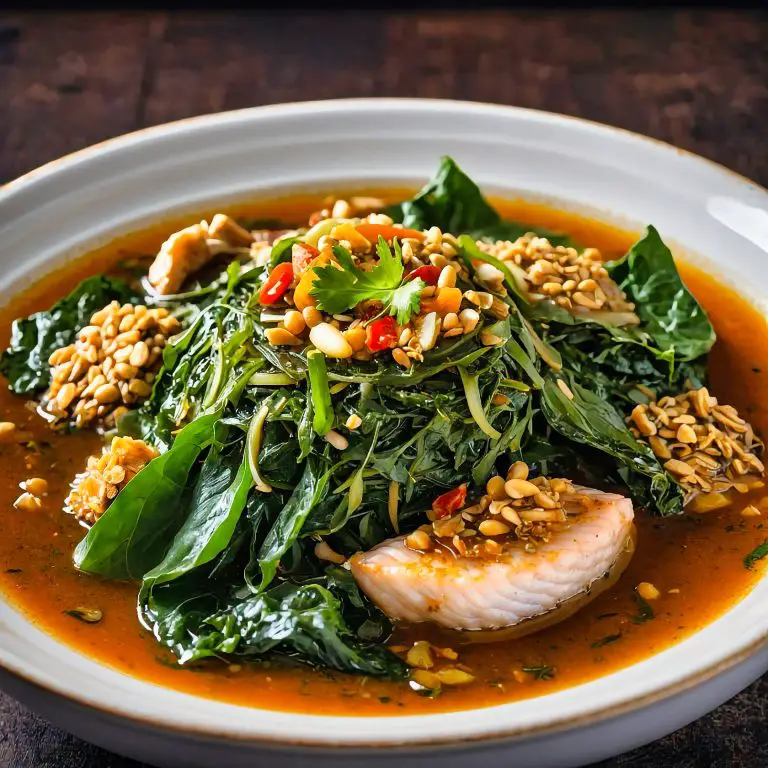The Congolese Fumbwa recipe is a traditional dish from the Democratic Republic of the Congo that brings rich flavors and hearty nutrition to the table. This Congolese wild spinach stew features a delightful mix of wild spinach, peanut butter, and palm oil, making it both satisfying and unique.
Fumbwa not only showcases the vibrant culinary culture of Congo but also provides essential vitamins and minerals.
As I explore this comforting recipe, I’ll share how to prepare it using fresh or dried ingredients while capturing the essence of this Congolese Fumbwa recipe.
The blend of savory ingredients, including smoked fish and spices, creates a dish that is both comforting and full of depth. I invite you to join me in discovering the joys of this Congolese Fumbwa recipe and how it represents the heart of Congolese cuisine.
Why You’ll Love This Congolese Fumbwa Recipe
I enjoy making the Congolese Fumbwa recipe because it showcases the flavors of Congolese cuisine. The use of wild spinach, known as fumbwa, gives the dish a unique taste and a rich green color.
This recipe is not only tasty but also nutritious. Fumbwa leaves are packed with vitamins and minerals, making this stew a healthy choice. Adding ingredients like peanut butter enhances the creaminess, making each bite satisfying.
The easy preparation is another reason to love this Congolese Fumbwa recipe.
I find it’s simple to soak the smoked fish and chop the spinach. Combining these ingredients creates a delightful, hearty stew.
Here are some key highlights of this recipe:
- Flavorful: A mix of fumbwa, peanut butter, and spices creates a rich taste.
- Nutritious: Packed with vitamins, it supports a healthy diet.
- Versatile: It pairs well with rice or can be enjoyed on its own.
- Cultural Experience: Cooking this dish connects me with Central African traditions.
Each time I prepare the Congolese Fumbwa recipe, I appreciate the warmth of this wild spinach stew. It brings a taste of the Congo to my kitchen, making every meal special.
What Makes This Congolese Fumbwa Recipe Special
I find that the Congolese Fumbwa recipe stands out because of its unique blend of ingredients. The main component is fumbwa leaves, which are also known as Gnetum africanum. These leaves have a slightly bitter flavor that adds complexity to the dish.
This recipe often includes other nutritious vegetables. The use of baby spinach and collard greens enhances the stew’s flavor and color. The addition of kale can also be a delightful twist.
Another standout feature is the rich, creamy texture. I love how the Congolese Fumbwa recipe incorporates peanut butter and red palm oil. This not only thickens the stew but also contributes a comforting richness.
The combination of flavors is impressive. Fresh ingredients like spring onions and garlic elevate the overall taste. This stew is not just filling; it’s truly satisfying.
In my experience, Fumbwa is more than just a dish. It reflects Congolese culture and culinary traditions. Certain variations even use cassava leaves, showcasing the diversity of ingredients available.
Every bite is a journey through flavors and textures, reminding me of the dish’s deep roots in African cuisine.
Cooking Equipment Needed
To make the Congolese Fumbwa recipe, having the right kitchen tools is important. Here’s what I use:
- Large Pot: A heavy-bottomed pot is best for even cooking and preventing burning.
- Cutting Board: I need a sturdy cutting board for chopping vegetables and meat.
- Knife: A sharp knife helps with cutting onions, spinach, and other ingredients.
- Measuring Cups and Spoons: These ensure I get the right amounts of each ingredient.
In addition, here’s a quick list of other helpful equipment:
- Colander: This is useful for draining rinsed spinach and any soaked ingredients.
- Wooden Spoon: I prefer using this for stirring. It’s great for mixing without scratching my pot.
- Ladle: For serving the stew, a ladle makes portioning easy.
- Grater: If using fresh ingredients like garlic or ginger, a grater can come in handy.
These tools make the cooking process smoother. By having everything prepared, I find it easier to follow the recipe and create a delicious dish.

Cooking Instructions
To make a Congolese Fumbwa recipe, I follow these steps:
- Prepare the ingredients:
- Chop the baby spinach and rinse it.
- Dice the spring onions and ripe tomatoes.
- Mince the cloves of garlic.
- Soak the fish:
- Take smoked catfish or dried fish and soak it in hot water for a few minutes.
- De-bone and break the fish into medium pieces.
- Cook the base:
- In a pot, heat palm oil.
- Add the chopped onions and minced garlic, cooking until soft.
- Add tomatoes:
- Stir in the diced tomatoes and cook until they break down.
- Combine everything:
- Add the chopped spinach to the pot.
- Mix in the broken fish, a chicken stock cube, and season with salt and black pepper.
- Create the Sauce:
- Add peanut butter for creaminess.
- If desired, include diced habanero pepper for heat.
- Simmer:
- Stir to combine and add a bit of water if needed for consistency.
- Cook until the spinach is soft.
These simple steps will bring rich flavors to my Fumbwa. Enjoy!
Cooking Tips
When preparing the Congolese Fumbwa recipe, I find using red palm oil essential for authentic flavor. It adds richness and a unique taste that complements the greens well.
I recommend soaking smoked fish in hot water before using it. This step makes the fish softer and easier to debone. After soaking, I chop the spinach and rinse it thoroughly to remove any grit.
Adding ground peanuts or peanut butteris key for texture and taste. I usually mix in a couple of tablespoons during cooking for a creamy finish.
As I cook the fumbwa leaves, I always keep an eye on the texture. They should become soft and tender, which usually takes around 10-15 minutes. If the stew appears too thick, I add a little water to balance the consistency.
Don’t forget to season your dish! Adding a touch of salt and any preferred spices can enhance the flavors. I often use garlic and spring onions for added aroma.
Lastly, serve Fumbwa warm with rice or cassava. This combination makes for a satisfying meal that showcases the rich flavors of Congolese cuisine.
Ingredients Needed for the Congolese Fumbwa Recipe
Onion, chopped
Garlic Cloves, minced
Fish, Smoked Catfish
Palm Oil
Peanut Butter
Tomatoes, chopped
Spinach
Bouillon Powder
Salt
Black Pepper
Stock
Habanero, optional
Water

Instructions For Preparing the Congolese Fumbwa Recipe
Prepare the Ingredients
Soak the smoked fish in hot water for a few minutes.
Chop the spinach, rinse thoroughly, and drain in a colander.
De-bone the smoked fish, break it into medium pieces, and rinse well.
Cook the Spinach
In a pot, bring 1 cup of water and 1 cup of stock to a boil.
Add the chopped spinach and simmer for 10 minutes.
Add the Main Ingredients
Mix in the smoked fish, diced tomatoes, habanero pepper, onion, garlic, and spices.
Bring to a boil, then simmer for another 10 minutes.
Finish with Peanut Butter and Palm Oil
Stir in peanut butter and palm oil, then simmer for a final 10 minutes.

FAQs for the Congolese Fumbwa Recipe
I know many people have questions about preparing the Congolese Fumbwa recipe. Below, I address common inquiries about its ingredients, preparation methods, and health benefits.
What ingredients are required for an authentic Congolese Fumbwa recipe?
For an authentic Congolese fumbwa recipe, I need wild spinach (fumbwa leaves), peanut butter, palm oil, onions, garlic, and spices. Some recipes also include smoked or dried fish, catfish, and pepper for added flavor. This combination creates a rich and creamy stew.
How can I make an easy version of the Congolese Fumbwa recipe at home?
To make an easy version, you can substitute fumbwa leaves with spinach or other leafy greens. I will sauté onions and garlic, then add the greens, peanut butter, and palm oil. Cooking everything together for 15-20 minutes can help simplify the process.
Which recipe is considered the best for making traditional Congolese fumbwa?
Many consider the Congolese Fumbwa recipe that includes wild spinach, peanut butter, and smoked fish as the best. This combination brings out the true flavors of the dish. I can follow traditional recipes from trusted Congolese cookbooks or sources for authenticity.
Can you prepare a Congolese Fumbwa recipe using a slow cooker, and how?
Yes, I can prepare my Congolese fumbwa recipe in a slow cooker. I would first sauté the onions and garlic on a stovetop, then transfer them to the slow cooker with the spinach and other ingredients. Cooking it on low heat for several hours allows the flavors to meld beautifully.
What are the health benefits associated with eating the Congolese Fumbwa recipe?
Fumbwa is rich in vitamins and minerals, especially iron, vitamins A, C, and K. The Congolese fumbwa recipe also has healthy fats from peanut butter and palm oil. Adding ingredients like boiled plantains or cassava as sides can enhance its nutritional value.
Are there any vegetarian alternatives within Congolese cuisine that include fumbwa?
Yes, there are vegetarian options. In meatless variants of fumbwa, I can skip the fish and use vegetable broth instead.
Other dishes in Congolese cuisine also feature plantains or cassava, providing additional options for those seeking vegetarian meals.

Congolese Fumbwa Recipe
Ingredients
- ½ Onion chopped
- 2 Garlic Cloves minced
- 8 oz Fish Smoked Catfish
- 2 tbsp Palm Oil
- 4 tbsp Peanut Butter
- 2 Tomatoes chopped
- 4 cups Spinach
- 1 tsp Bouillon Powder
- ½ tsp Salt
- 1 tsp Black Pepper
- 1 cup Stock
- 1 Habanero optional
- 1 cup Water
Instructions
Prepare the Ingredients
- Soak the smoked fish in hot water for a few minutes.
- Chop the spinach, rinse thoroughly, and drain in a colander.
- De-bone the smoked fish, break it into medium pieces, and rinse well.
Cook the Spinach
- In a pot, bring 1 cup of water and 1 cup of stock to a boil.
- Add the chopped spinach and simmer for 10 minutes.
Add the Main Ingredients
- Mix in the smoked fish, diced tomatoes, habanero pepper, onion, garlic, and spices.
- Bring to a boil, then simmer for another 10 minutes.
Finish with Peanut Butter and Palm Oil
- Stir in peanut butter and palm oil, then simmer for a final 10 minutes.
Nutrition



4 comments
I just made this fumbwa for the first time, and it turned out fantastic! The spinach-like leaves cooked down beautifully, absorbing all the delicious flavors of the peanut sauce and spices. The texture was smooth yet hearty, and it paired wonderfully with rice. My guests loved how rich and creamy it was, and they couldn’t stop praising the perfect balance of flavors. Definitely a dish I’ll be making again!
I cant believe they didnt mention the best way to serve this Fumbwa recipe! Have you tried pairing it with a spicy mango salsa? Trust me, it takes it to a whole new level!
Im not so sure about this Congolese Fumbwa Recipe. Seems a bit too complicated with all the cooking equipment needed. I prefer simple recipes that dont require a whole kitchen worth of tools. What do you guys think?
I dont know about you guys, but Im curious about the history behind the Congolese Fumbwa recipe. How did it come about? Any interesting stories or traditions attached to it? Lets dive deeper into the cultural aspect next time!